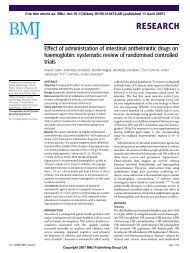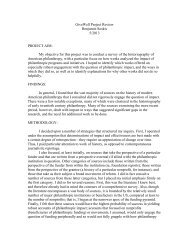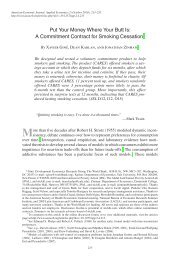Getting In Staying On Moving Up - GiveWell
Getting In Staying On Moving Up - GiveWell
Getting In Staying On Moving Up - GiveWell
You also want an ePaper? Increase the reach of your titles
YUMPU automatically turns print PDFs into web optimized ePapers that Google loves.
GETTING IN, <strong>Staying</strong> on, <strong>Moving</strong> <strong>Up</strong> 9<br />
consistently tardy client will have repeated<br />
opportunities to change behavior with<br />
VFI’s support. When the time comes for a<br />
real job, the transition to a rigid work<br />
schedule is not nearly as abrupt, and success<br />
is more likely.<br />
Key staff roles<br />
VFI’s emphasis on smooth transitions has<br />
led it to create an unusual staff structure<br />
that provides both a clear delineation of<br />
roles and shared responsibility for client<br />
outcomes. Over the course of the program,<br />
students in <strong>Moving</strong> <strong>Up</strong> deal with four categories<br />
of professional staff: case managers,<br />
who are their first mentors in the program;<br />
instructors, who teach classes; job developers,<br />
who broker most of their employment<br />
opportunities; and career advisors, who<br />
guide their transition into work and continue<br />
to advise and encourage them afterward.<br />
The responsibilities of these staff<br />
members deliberately overlap, a feature<br />
that has proved to be a significant strength<br />
of the program.<br />
During training, students’ focus is mainly<br />
inward, on their skills and readiness for<br />
employment. Case managers offer continuing<br />
motivation and employment-readiness<br />
training during this period, and they<br />
address housing, health and other personal<br />
issues. Meanwhile, instructors focus mainly<br />
on skills development. But beginning in<br />
the fourth month of training, the main<br />
responsibility for students’ success starts to<br />
pass gradually from a case manager to a<br />
career advisor, who helps turn their focus<br />
outward, toward employment. About this<br />
same time, a job developer also takes<br />
responsibility for each trainee, completing<br />
the three-person team that will guide the<br />
student into a job and beyond. Because the<br />
move from training to paid employment is<br />
the most difficult transition in any employment<br />
program, the <strong>Moving</strong> <strong>Up</strong> design<br />
deliberately increases the level of support<br />
during this critical period—when all four<br />
levels of professional staff are working with<br />
students in concert.<br />
Without careful management, these intertwined<br />
responsibilities could provide an<br />
unwelcome opportunity for the client to<br />
fall through the cracks or get tangled in<br />
staff turf battles. But at VFI, the transition<br />
is governed by a carefully orchestrated<br />
hand-off of responsibilities that extends for<br />
up to two months over this critical trainingto-work<br />
period. <strong>In</strong>stead of staff conflicts,<br />
the overlapping roles in <strong>Moving</strong> <strong>Up</strong> are<br />
precisely calibrated to encourage team<br />
effort and smooth transitions.<br />
To understand the various roles and how<br />
they interact, it may be simplest to divide<br />
the program into its main stages. This section<br />
deals with the stages leading up to<br />
placement and the following one covers the<br />
remainder of the program.

















